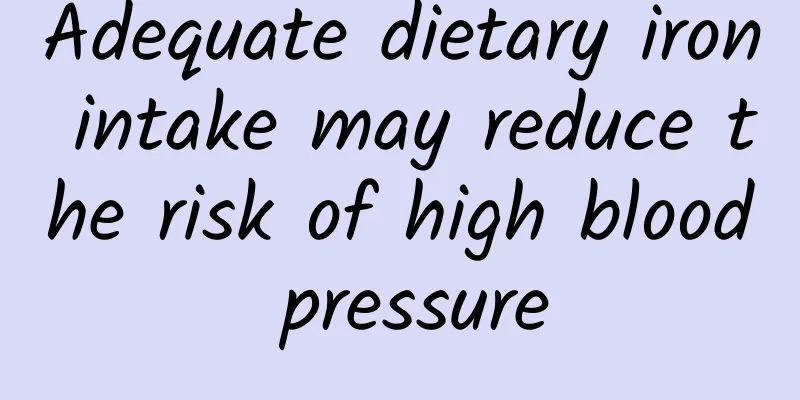Adequate dietary iron intake may reduce the risk of high blood pressure

|
Hypertension is called the "silent killer" because it rarely shows very obvious symptoms. More than half of strokes and heart attacks are caused by high blood pressure, and high blood pressure also increases the risk of chronic diseases such as kidney disease and dementia. In low-income and middle-income countries, the prevalence of hypertension is still rising rapidly. In China, there are currently about 245 million adults with hypertension. Actively looking for modifiable risk factors for hypertension is of great significance to preventing and controlling the occurrence and development of hypertension and reducing the harm of hypertension complications. Among them, a reasonable diet and a healthy lifestyle are important strategies for preventing and managing hypertension. (Pictures from the Internet, copyright belongs to the original author) Iron is one of the essential trace elements for the human body and is involved in the formation of hemoglobin, oxygen transport, DNA synthesis, mitochondrial electron transfer and muscle function. Dietary iron exists in food in the form of heme iron and non-heme iron. A recent study published in the biomedical journal J Nutr Health Aging found that the relationship between dietary iron and the risk of new-onset hypertension is nonlinear. There is a U-shaped relationship between total iron and non-heme iron intake and the risk of new-onset hypertension, while there is an L-shaped relationship between heme iron intake and the risk of hypertension. Dr. Zhang Zhuxian is the first author and Professor Qin Xianhui is the corresponding author. The study was a prospective cohort study based on data from the China Health and Nutrition Survey, which included 12,245 Chinese adults without baseline hypertension. Dietary iron intake data were collected through 24-hour dietary recall and household food inventory for 3 consecutive days, and the cumulative mean of iron intake represented its long-term exposure level. New-onset hypertension was defined as hypertension diagnosed by a physician during follow-up, use of antihypertensive drugs, systolic blood pressure ≥140 mmHg and/or diastolic blood pressure ≥90 mmHg. After 6.1 years of follow-up, 4,304 participants developed hypertension. The study found that there was a U-shaped relationship between total dietary iron intake and the risk of new-onset hypertension (Figure 1A), and the risk of hypertension was lowest when total dietary iron intake was between 18.2-22.1 mg/d. Similarly, there was a U-shaped relationship between dietary non-heme iron intake and the risk of new-onset hypertension (Figure 1C), and the risk of hypertension was lowest when dietary non-heme iron was between 17.4-1.3 mg/d. However, there was an L-shaped relationship between dietary heme iron intake and the risk of new-onset hypertension (Figure 1B), and the risk of hypertension was significantly reduced by 25% in those with a dietary heme iron intake of more than 0.25 mg/d compared with participants with a dietary heme iron intake of less than 0.25 mg/d. An unreasonable diet is the main cause of disease and death in the Chinese population, and it is also an adjustable risk factor that is easy to correct and improve. The results of this study emphasize the importance of maintaining an appropriate amount of iron intake through a reasonable diet for the primary prevention of hypertension in the Chinese population. References: Zhang Z, Liu C, Liu M, Zhou C, Li Q, He P, Zhang Y, Li H, Qin X. Dietary Iron Intake and New-Onset Hypertension: A Nationwide Cohort Study from China. J Nutr Health Aging . 2022;26(11):1016-1024. Editor | Zhang Zhuxian and Wu Yiting Audit | Qin Xianhui Reprint: Please contact us and indicate the source. |
>>: The trial of a bottle of "human albumin"
Recommend
Why do pimples appear on the areola?
Some pregnant women will find bumps on their areo...
How to fillet fish without bones when boiling it? Should I use high or low heat when boiling fish?
When boiling fish, the amount of water should not...
Lumbar disc herniation: from cause to treatment
Lumbar disc herniation : from cause to treatment ...
iRsearch: Five major reviews of China's mobile Internet industry in 2011
2011 was a year of accelerated development of Chi...
This part of the chicken should never be eaten! Most people don't know...
Chicken has high nutritional value and is cheap, ...
What to do if there are lumps in the milk
After giving birth, women still need to breastfee...
Why is postpartum illness afraid of cold?
Postpartum disease is a traditional term of ours,...
Can we predict adult height by cracking the "code" of bone age?
Author: Li Kai, attending physician, Beijing Jish...
Is it okay for a girl to have a lot of messy lines on her palms?
In everyone's impression, the lines on a girl...
Can the magical "gene scissors" bring new hope for curing AIDS?
Author: Duan Yuechu AIDS is a serious immune syst...
Drinking Isatis Root when you are sick? A man was poisoned and fell into a coma! Pay attention to these 5 points when taking it →
Recently, Mr. Zhang, 40, was sent to the hospital...
Can pregnant women blow dry their hair?
The physical condition of the mother after giving...
Can I keep the baby if I do CT during pregnancy?
Many women will try to keep fit during pregnancy ...
How do indoor ants come into being? How to eliminate ants on the bed
Ants are a type of insect with many species, with...









